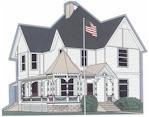|
North Baltimore Area
Historical Center
Homepage
This area, formerly the "Black Swamp", was nothing but mud, muck and mire surrounded by dense forests when it was first settled in the mid-1800's. The people have a history rich in religion and education, combined with a robust heritage, typical of the early oil boom and railroading days.
One of the first buildings erected served as a combination schoolhouse, church and meeting hall. The structure was built by B.L. Peters in 1860 at the cost of $550 and was located on what is now the northwest corner of Main Street and Broadway. At that time, before the town had an official name, it was a small hamlet composed of two stores, a few dwellings and the meeting hall. The latter building served as the meeting place for the congregation of the United Brethren Church, which was chartered in 1861 as the first church in Henry Township. Today it is known as The Church of The Good Shepherd United Methodist. B.L. Peters was the first Sunday School superintendent, the first schoolteacher and later the town's first mayor.
First settlers in the community were Jacob Dirk, George Franks, Levia A. Tarr and B.L. Peters. It wasn't until 1873 that the first plat, consisting of 29 acres, was filed by Peters, naming the town "New" Baltimore. Shortly after that, plats were filed by Jacob Dirk, George Franks, Levia A. Tarr, and Peters, and the birth of the community had taken place.
The Baltimore and Ohio Railroad tracks were laid through town in November 1873 and the community began to grow. The B & O provided east and west travel with 12 passenger trains daily. Today the tracks serve as the mainline of the Chessie Railroad, with 24 freight trains passing through daily. On February 7, 1876 the request was granted to incorporate the Village of North Baltimore. The 1880 census credited the village with 701 residents. Also, that year, the towns name was changed to North Baltimore, after it was discovered that another town in Ohio had the name of "New" Baltimore.
The first oil well was drilled on North Second Street. It was later that year when the most famous early "gusher" was drilled on the Dave Fulton farm, located near the corner of Oil Center and Mitchell Roads, north of town.
Discovery of natural gas also took place in 1886 when the first well was drilled on the Peters Farm on East Broadway.
|
|





